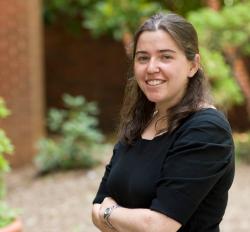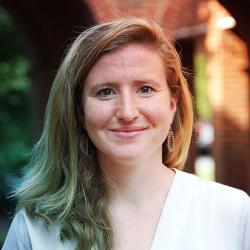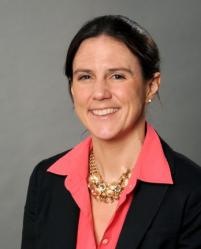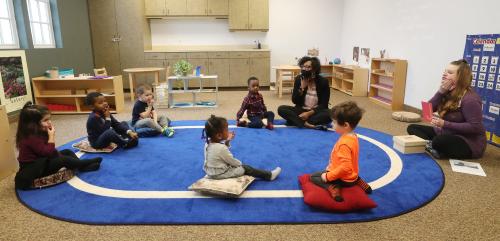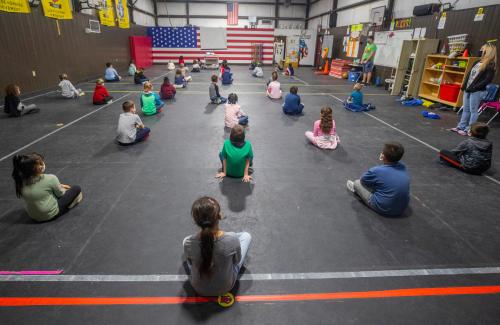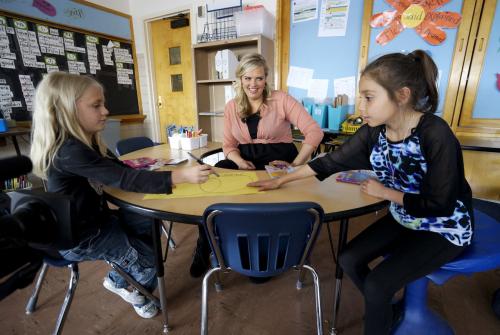Co-authors Daphna Bassok, Anna Markowitz, and Pamela A. Morris are researchers with longtime research-practice partnerships (RPPs). They wrote the opening piece to a new volume of The Future of Children, entitled “Research-Practice Partnerships to Strengthen Early Education,” which focuses on the ways that RPPs can help researchers and practitioners work together to build stronger early childhood education systems. For this blog post, they interviewed fellow co-author Jenna Conway, chief school readiness officer for the Virginia Department of Education, about the value she sees in partnering with researchers.
“The kids I am most worried about right now are those who are not enrolled in public preschool and kindergarten,” says Jenna Conway, chief school readiness officer at the Virginia Department of Education (VDOE). Preschool and kindergarten teachers have been telling her that many families seemed to opt out in the fall and children have been disappearing from virtual classrooms since the beginning of the year. She saw this happen in her own child’s virtual kindergarten class and wondered how widespread this was around Virginia. How many and which children were leaving? What kinds of alternative experiences were they having? And what will these enrollment drops mean for children in the months and years to come?
“It is unusual to see so many families either opting out altogether or dropping out midyear,” she told us. “We need data to understand what is going on so we can figure out how to adjust policy and resources for the field.”
This isn’t the first time Conway has looked to data for insights on how to address a policy challenge. Through multiple, longstanding research–practice partnerships (RPPs) with university-based researchers, she has advocated for fast-turnaround data collection and analyses that allow her to repeatedly “take the pulse” of young children’s experiences throughout the pandemic.
These analyses have illuminated a variety of challenges. They showed a nearly 20% drop in pre-K enrollment overall, as well as higher drop rates for Black and Hispanic children, and children from low-income families. Fall assessment data showed that over a quarter of incoming kindergarteners—far more than in any other year—were at risk for reading failure. A survey of nearly 2,000 preschool teachers revealed that most of those teaching remotely (81%) thought that children were learning less than usual. Many were concerned that they didn’t have enough interaction with students to know if their students were doing okay. Indeed, surveys with over 5,000 Virginia parents of young children showed that many are concerned about their children, not only about their academic development but also their social skills and mental health.
These state-level data are helping Conway and her colleagues at VDOE and the governor’s office to understand the impact of COVID-19 on Virginia’s youngest learners, refine practices to meet children’s needs, and make strategic investments. For instance, data highlighting under-enrollment and children’s widely varying needs helped Conway advocate for waivers that allow children who are age-eligible for kindergarten to enroll in state-funded pre-K classrooms if that environment would better meet their needs.
Conway believes that all policymakers, superintendents, principals, and teachers benefit from seeing their own local, real-time data. These data can help them understand the scope of the problems they face, balance competing goals amid challenges, and assess whether their solutions are working. However, practitioners are busy, and especially so in the context of a pandemic.
That’s where RPPs can be powerful. Researchers are often criticized for failing to tackle the questions that are most urgent on the ground and working too slowly to provide useful information on policy timelines. Over the past decade, however, a growing number of policymakers, practitioners, and researchers have built partnerships that align research with practice—partnerships that can meet the immediate needs of leaders like Conway while informing early childhood research more broadly.
New Volume on Research Practice Partnerships Released last Week
A year ago, when the world responded to COVID-19 by closing down in-person instruction nearly overnight, the need for this type of research partnership was clear. But partnerships have long been a part of early childhood education (ECE) research. In a new volume of The Future of Children released last week, researchers, policymakers, and practitioners involved in early childhood RPPs around the country provide insights into how partnerships can lead to better research and better practice in the early education sector.
The volume highlights lessons from these partnerships. Each article is centered around a major challenge or opportunity in partnership work—for example, creating a research and/or funding agenda, developing tools, taking innovation to scale, navigating timelines, and capacity building. Together, they provide a road map for researchers and policy/practice leaders who want to break research and policymaking siloes, ask better scientific questions, collect stronger data, and create immediately applicable knowledge.
Such efforts to bridge research and practice were particularly valuable during the pandemic, and many of the partnerships profiled in this volume pivoted quickly at COVID-19’s onset to address pressing partner questions. RPPs in New York City, Louisiana, and Virginia quickly gathered detailed data about the impact of COVID-19 on early educators. A partnership in Boston studied how COVID-19 impacted young children’s learning environments in both in-person and remote settings.
For Conway, this process of rapid, local data collection is essential both for diagnosing problems and for building a coalition of support for policy solutions. “Using local data from trusted sources gets more people on board because they care most about what is happening in their own communities,” she says. “It also helps illustrate who is being most affected and helps build the case for making those children and families the priority.”
And while RPPs over the past year have focused on gathering fast-turnaround data to help policymakers better understand the scope and nature of the problems COVID-19 created, moving forward they can track improvement and guide the redesign of early childhood systems for a post-pandemic world. For instance, New York University’s partnership with New York City is studying the challenges and innovations of pre-K educators during the COVID-19 pandemic, findings that will be used to inform programmatic supports for families in the future.
The United States is making unprecedented investments in early childhood education (e.g., the CARES Act) and considering bold new ways to improve access and quality at scale. Policymakers have a unique opportunity to experiment with new approaches to ECE system-building and they need help evaluating which strategies yield desired results. For researchers, this creates a unique opportunity to move from “relevant” research to research that directly informs practice and policymaking. For policymakers, finding ways to integrate research partners into practice teams can offer access to additional capacity for high-stakes recovery and rebuilding efforts. Though creating strong, trusting partnerships takes time, it is time well worth spending—for researchers, for practitioners, and for policymakers—in order to build better programs for our youngest learners.
The Brookings Institution is committed to quality, independence, and impact.
We are supported by a diverse array of funders. In line with our values and policies, each Brookings publication represents the sole views of its author(s).
